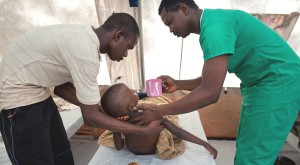Waste Manag. 2012 Aug 25.
Sustainable sanitary landfills for neglected small cities in developing countries: The semi-mechanized trench method from Villanueva, Honduras.
Oakley SM, Jimenez R. Department of Civil Engineering, Chico State University, California State University, Chico, CA 95929, United States.
Open dumping is the most common practice for the disposal of urban solid wastes in the least developed regions of Africa, Asia and Latin America. Sanitary landfill design and operation has traditionally focused on large cities, but cities with fewer than 50,000 in population can comprise from 6% to 45% of a given country’s total population. These thousands of small cities cannot afford to operate a sanitary landfill in the way it is proposed for large cities, where heavy equipment is used to spread and compact the waste in daily cells, and then to excavate, transport and apply daily cover, and leachate is managed with collection and treatment systems.
This paper presents an alternative approach for small cities, known as the semi-mechanized trench method, which was developed in Villanueva, Honduras. In the semi-mechanized trench method a hydraulic excavator is used for 1-3 days to dig a trench that will last at least a month before it is filled with waste. Trucks can easily unload their wastes into the trench, and the wastes compact naturally due to semi-aerobic biodegradation, after which the trenches are refilled and covered. The exposed surface area is minimal since only the top surface of the wastes is exposed, the remainder being covered by the sides and bottom of the trench. The surplus material from trench excavation can be valorized for use as engineering fill onsite or off.
The landfill in Villanueva has operated for 15years, using a total land area of approximately 11ha for a population that grew from 23,000 to 48,000, with a land requirement of 0.2m(2)/personyear, a cover to waste ratio of 0.2, and an estimated soil surplus of 298,000m(3) that is valorized and used onsite. The landfill has been operated solely by the municipality with an operational cost in 2010 estimated at US$4.60 per ton. A modified water balance analysis at Villanueva shows negligible leachate generation from covered trenches and 700m(3)/yr (60m(3)/hayr) from the two open trenches required for daily operation. If the site were an open dump, however, leachate generation is estimated to be 3900m(3)/hayr and contaminated runoff 5000m(3)/hayr.
A simple model used to estimate dilution of generated leachate based on groundwater flow data and aquifer stratigraphy suggests that the leachate will be diluted by a factor of 0.01 in the aquifer. Leachate contaminants will not accumulate because the aquifer discharges to the Ulua River 2km south of the landfill. While not suitable for all sites, the Villanueva method nevertheless serves as an excellent example of how a small city landfill with natural compaction of waste and attenuation of leachate can be sustainably operated.







